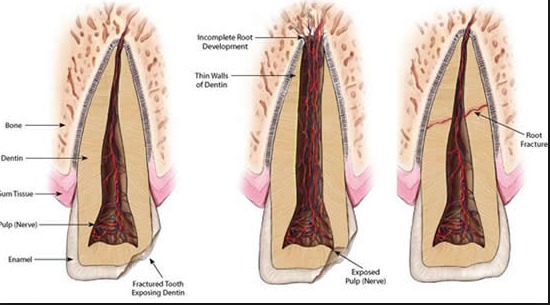Teeth injuries most often occur during sports activities, accidental falls, car accidents, or altercations. The extent of the injuries may range from minor enamel chipping all the way to significant fracture of the supporting bone. Such injuries and potential loss of teeth have great emotional impact on patients and their families and hence require immediate attention. The treatment and decision regarding whether to save the teeth or remove them is based on the type of injury, its severity, and the condition of the surrounding tissues. A proper diagnosis, with thorough clinical exam, x-rays, and cone beam CT scan when appropriate, is critical for choosing the right treatment. Here are the main types of injuries and treatment recommendations:

- Tooth fracture involving just the enamel – These are superficial injuries requiring only cosmetic repair of the fractured enamel with bonding or veneers. The tooth vitality should be tested for several months after the injury.
- Tooth fracture involving enamel and dentin – If there is no evidence of bleeding at the center of the tooth, then the fracture has not reached the pulp of the tooth. In this case the tooth can be repaired with bonding, veneer, or crown. In some cases, the pulp may undergo gradual breakdown (pulpal necrosis) where a root canal treatment will become necessary. Therefore it is best to follow up with a root canal specialist (endodontist) for monitoring. If there is bleeding at the center of the tooth, then pulp exposure has occurred. In this case, the tooth requires root canal treatment and then restored with appropriate bonding, veneer, or crown.
- Tooth fracture at or below gum tissue – This is a more severe type of tooth injury and requires the tooth to be extracted. Depending on the condition of the supporting bone and gum tissue, a dental implant may be placed immediately, or the site is grafted first and then the implant is placed after 4-6 months of healing. A transitional prosthesis is provided in the interim.
- Tooth loosening or displacement (subluxation) – There are two approaches based on the severity of the displacement:
- Reposition and splint – If the tooth has suffered a mild to moderate displacement, it may be possible to reposition and splint it for about 4 weeks. At this time, a root canal treatment is required as the pulp becomes necrotic. An appropriate final restoration is then placed. Long-term monitoring is required since such injuries can result in root resorption over time.
- Extract and graft or place immediate implant – If the tooth is severely displaced and loosened, then it maybe best to extract it and then either graft to preserve the bone, or place an immediate dental implant.
- Tooth completely knocked out of the mouth (avulsion) – In most circumstances, it is not possible to save the tooth. It is best to either graft the site to preserve or augment the bone, or place an immediate dental implant.
When is it possible to save a tooth that has been completely knocked out? It may possible to put the tooth back in its socket and splint it in an attempt to save it IF ALL OF THE FOLLOWING CRITERIA ARE MET:
- The tooth is clean and not contaminated by dirt or debris.
- The tooth is intact and not fractured .
- The tooth is handled only by the crown (the root is not touched)
- The tooth is kept from getting dry by keeping it in milk or saliva
- The tooth is re-implanted within 30 minutes
- The bone where the tooth was lost is intact and healthy.
If all criteria are met, then the tooth can be reimplanted and splinted for 4 weeks. Root canal treatment is then completed and the tooth is restored as needed. Long-term follow-up and monitoring is necessary as root resorption is common. Since the prognosis, even under the best conditions, is still uncertain, this type of injury is more commonly treated now with dental implant placement, which offers greater long-term success.
- Fracture of supporting bone – If the teeth are intact but the supporting bone has been fractured, then the segment can be reduced and stabilized with wires. Such injuries are known as dentoalveolar fractures, which is a partial jaw bone fracture. Once the loose segment is repositioned, it is held in place using a wire bonded to adjacent teeth for 6 weeks. The teeth should be checked for vitality later and treated with root canal if necessary.
The decision to save or extract a tooth that has suffered injury is based on the condition of the tooth and outlook for its long-term success. With severe injuries, even if the tooth can be saved, it is typically unpredictable and risky. In such instances, it is best to extract the tooth and replace with a dental implant. Otherwise the tooth should be saved if the treatment can assure at least an 80% success. Your oral surgeon and restorative dentist along with collaboration of an endodontist can provide you with the best treatment options.